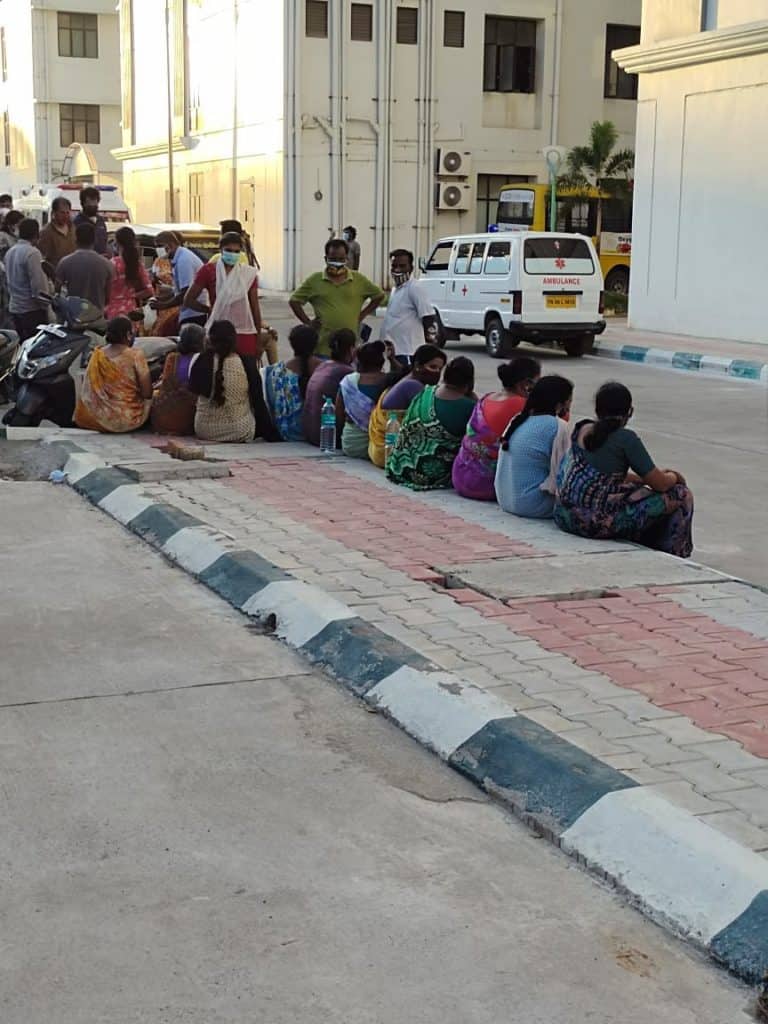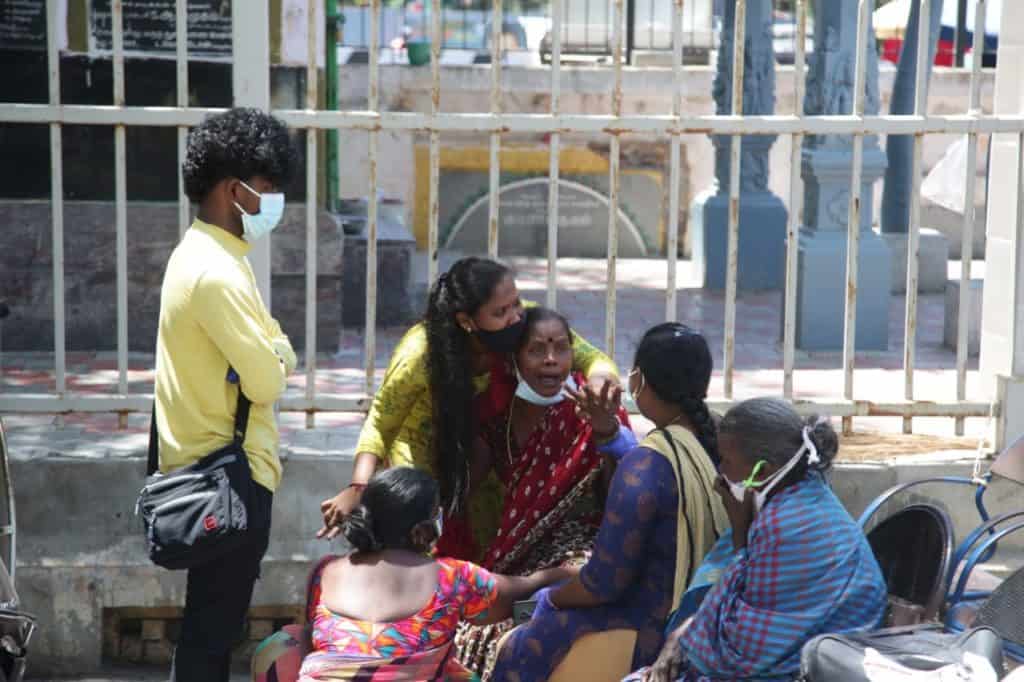Indulekha (name changed) from ECR nearly had a nervous breakdown when her father’s oxygen saturation levels dipped to 78. COVID treatment for her 72-year-old father at a private hospital was something she could not consider. “They quoted a sum of Rs 2 lakh a day for ventilator support. How can a lower middle class family like ours ever afford it?” Indulekha questioned. Her only choice was to go for the government hospitals.
On May 4th, the family waited outside the Rajiv Gandhi Government General Hospital and Stanley Medical College hospital for hours, in vain. “Multiple calls to the 104 helpline (a unified command centre for COVID management) were of no use. The helpline staff was responsive but couldn’t provide an oxygen bed for Indulekha’s father,” said Bharathi Ramanan, a volunteer with Covid Voluntary Force, Chennai, who helped Indulekha.
After a day of battling the virus, Indulekha’s father passed away in the wee hours of Wednesday (May 5th) at his home.
As of May 10th, none of the government and private hospitals in the city had oxygen beds to treat critical COVID patients with perilous oxygen saturation levels. At the COVID ward of the Stanley Medical College hospital, patients lie on the floor due to non-availability of beds, revealed a duty doctor, seeking anonymity.
Oxygen crunch
We saw it happening in New Delhi. We saw it happening in Bengaluru. And now the crisis has hit home, with oxygen crisis and bed shortage being a stark reality in Chennai today. Private hospitals are refusing to admit new patients, citing oxygen shortage as the reason. “We cannot admit new patients as we have no reserves of oxygen. The current supply is only enough for existing patients,” said a doctor from a private hospital in Tambaram.
After a request from the Tamil Nadu Chief Minister M K Stalin, the centre increased the oxygen supply from 220 to 419 metric tonnes a day. Also, the city is home to many oxygen production companies such as INOX Air products and Tamil Nadu Oxygen Private Limited. The question, then, is: why is Chennai gasping for oxygen then?
The issue has more to do with the logistics surrounding oxygen supply. “The Chennai district collector ordered us to supply oxygen only to the hospitals, prioritising government hospitals. There can be no dearth of oxygen supply as we are abiding by the order,” said G Yuvaraj, plant in charge, Tamil Nadu Oxygen Private Limited, Ambattur. The plant runs 24 hours a day and produces 10 tonnes of oxygen.
But storage, transport and sudden hike in prices are inter-linked factors behind the empty oxygen cylinders in private hospitals. “There are not many cryogenic tankers to transport and save oxygen. Making one such tanker takes more than a month,” added Yuvaraj.
While the major government hospitals have cryogenic tankers that enable storing oxygen for ten days, the limited numbers of cryogenic tankers and oxygen cylinders are leaving a strong impact on private hospitals. “It takes five days for oxygen to reach us after we place an order with the dealers. As we did not expect a spike in cases to this extent, there is a shortage of cylinders. In order to meet the demand, we are now buying old cylinders that were once used for transporting oxygen to industries,” added the doctor from the Tambaram hospital.
Read More: Why are patients struggling to find hospital beds in Chennai?
What went so wrong?
As cases surged, so did the demand for oxygen. “Oxygen cylinder distributors have raised prices due to demand. Hospitals that have had tie ups with distributors for decades are now left in the lurch. As they cannot afford the prices, they are on the lookout for more affordable ones,” said the doctor from Stanley Medical College Hospital, revealing that this has played a role in the shortage of oxygen in government hospitals too. “There are around 30 high-flow nasal cannula beds (where large amounts of oxygen are provided to the patient suffering from breathlessness). But we have not been using them as they consume a lot of oxygen and we cannot drain the reserves. We are treating many patients in the normal wards, even though it takes a longer time this way,” the doctor added.
The oxygen crisis in Chennai can also be attributed to the misjudgement by the state and central governments and their inability to gauge the looming crisis. “Why were additional beds not added in the government hospitals? Why didn’t the private hospitals take care of the oxygen logistics? Even when a second wave was inevitable, the state government continued with a piecemeal approach in readying the facilities,” says Dr Shanthi Ravindranath, secretary of Chennai’s Doctors’ Association for Social Equality.
“Oxygen produced in Tamil Nadu is distributed to other states, despite the spiking cases here. While the requirement in Chennai itself is dynamic, the central government made gross miscalculations while determining the state’s share of oxygen,” she added.
Equipped with a number of COVID care centres, Chennai is prepared to provide medical support to the patients with mild symptoms such as fever. However, hammered by the second wave of the virus, the city has seen a spike in the number of patients with pneumonia and deteriorating SpO2 levels, and therefore, beds with external oxygen support is the need of the hour.
When there’s enough oxygen, but no beds
“Patients with oxygen saturation below 90% require oxygen support. If a patient or attendant feels that oxygen levels are deteriorating or lower than normal, they are advised to seek immediate medical intervention,” says Dr Shreevidya Venkatraman, Senior Consultant, Internal Medicine, MGM Healthcare. In the early days of the crisis, government hospitals came to the aid of such patients in the city. But the situation has changed over the past week. With numbers shooting up exponentially, even with enough oxygen reserves, government hospitals are having to send back emergency patients. Reason: a shortage of beds.

Bed shortage is a gripping issue in both government and private hospitals, claiming lives everyday. Families of critically affected patients are desperate to find a bed. The long queues outside the government hospitals bear testimony to the disastrous situation in Chennai.
Venkatesh B G, says he must have made the rounds of nearly 50 private and government hospitals in the city, seeking a bed for his 55-year-old uncle. “He was short of breath and needed immediate medical care. But, we got him admitted after more than a day of seaching for hospitals. Some did not even pick the calls,” said Venkatesh, who has admitted his uncle in a private hospital at Selaiyur. Ten days after admission, his uncle remains critical.
“At least 20 people go back home everyday due to non-availability of beds. All the 150 ICU and ventilator beds and 760 ward beds in the hospital are full,” said a PG doctor from Stanley Medical College hospital.
Read More: COVID second wave in Chennai: What to do if you test positive
Reality check
The situation is so grim that hospital managements now have to choose between patients. In a reality check conducted by Citizen Matters Chennai, it was understood that the hospitals admit patients only after checking their age, CT scan and SpO2 levels. A 74-year-old COVID patient with poor SpO2 levels was recently denied admission by both private and government hospitals.
Volunteers on the ground corroborate the story. “A 35-year-old patient with SpO2 levels of 80 is prioritised over a 50-year-old with the same SpO2 levels. The deficiency of infrastructure is so real that the management has to choose,” said Bharathi Ramanan, who has been helping critically ill patients secure hospital admissions.
The health department, however, remains optimistic of meeting the demand for oxygen under the current circumstances. “We are equipped to add 5000 beds across the state if the demand shoots up. Oxygen needs in the state are currently met with increased supply from Kerala and within the state,” said Dr T S Selvavinayagam, Director of Public Health and Preventive Medicine, Tamil Nadu government. When asked if the state has stored enough oxygen for critical circumstances, he said that over 1200MT of oxygen is stored at the facilities in the major government hospitals of the state.
How these reserves will be actually be administered to patients in facilities struggling with inadequate infrastructure in the face of exploding numbers is an entirely different matter, of course. “I know I am dying. I have no hope of getting an admission in any of the hospitals. Let us go home,” were the final words of Indulekha’s father. If only Chennai had worked on equipping and upgrading its health care facilities during the lean period between the two waves, Indulekha’s father would have been alive today.

